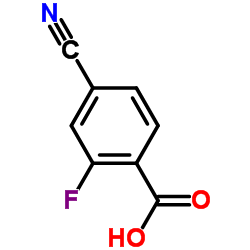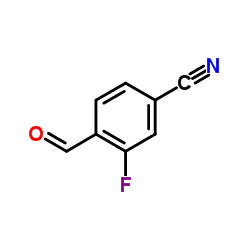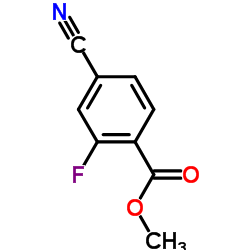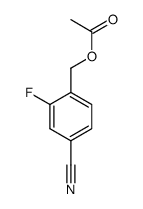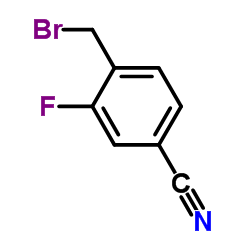219873-06-0
| 中文名 | 4-氰基-2-氟苄醇 |
|---|---|
| 英文名 | 3-fluoro-4-(hydroxymethyl)benzonitrile |
| 中文别名 |
3-氟-4-(羟甲基)苯腈
4-氰基-2-氟苯甲醇 |
| 英文别名 |
3-Fluoro-4-(hydroxymethyl)benzonitrile
4-cyano-2-fluorobenzyl alcohol 3-fluoro-4-hydroxymethylbenzonitrile Q1R BF DCN |
| 密度 | 1.3±0.1 g/cm3 |
|---|---|
| 沸点 | 288.8±30.0 °C at 760 mmHg |
| 熔点 | 63-68 °C |
| 分子式 | C8H6FNO |
| 分子量 | 151.138 |
| 闪点 | 128.5±24.6 °C |
| 精确质量 | 151.043335 |
| PSA | 44.02000 |
| LogP | 0.28 |
| 蒸汽压 | 0.0±0.6 mmHg at 25°C |
| 折射率 | 1.546 |
| 储存条件 | 室温,干燥,惰性气体存储 |
|
SECTION 1: Identification of the substance/mixture and of the company/undertaking Product identifiers Product name: 3-Fluoro-4-(hydroxymethyl)benzonitrile REACH No.: A registration number is not available for this substance as the substance or its uses are exempted from registration, the annual tonnage does not require a registration or the registration is envisaged for a later registration deadline.
CAS-No.: 219873-06-0 Relevant identified uses of the substance or mixture and uses advised against Identified uses: Laboratory chemicals, Manufacture of substances SECTION 2: Hazards identification Classification of the substance or mixture Classification according to Regulation (EC) No 1272/2008 Serious eye damage (Category 1), H318 For the full text of the H-Statements mentioned in this Section, see Section 16. Classification according to EU Directives 67/548/EEC or 1999/45/EC Xi IrritantR41 For the full text of the R-phrases mentioned in this Section, see Section 16. Label elements Labelling according Regulation (EC) No 1272/2008 Pictogram Signal wordDanger Hazard statement(s) H318Causes serious eye damage. Precautionary statement(s) P280Wear protective gloves/ eye protection/ face protection. P305 + P351 + P338IF IN EYES: Rinse cautiously with water for several minutes. Remove contact lenses, if present and easy to do. Continue rinsing. Supplemental Hazardnone Statements Other hazards - none SECTION 3: Composition/information on ingredients Substances Synonyms: 4-Cyano-2-fluorobenzyl alcohol Formula: C8H6FNO Molecular Weight: 151,14 g/mol CAS-No.: 219873-06-0 Hazardous ingredients according to Regulation (EC) No 1272/2008 ComponentClassificationConcentration 4-Cyano-2-fluorobenzyl alcohol Eye Dam. 1; H318- Hazardous ingredients according to Directive 1999/45/EC ComponentClassificationConcentration 4-Cyano-2-fluorobenzyl alcohol Xi, R41- For the full text of the H-Statements and R-Phrases mentioned in this Section, see Section 16 SECTION 4: First aid measures Description of first aid measures General advice Consult a physician. Show this safety data sheet to the doctor in attendance. If inhaled If breathed in, move person into fresh air. If not breathing, give artificial respiration. Consult a physician. In case of skin contact Wash off with soap and plenty of water. Consult a physician. In case of eye contact Rinse thoroughly with plenty of water for at least 15 minutes and consult a physician. If swallowed Never give anything by mouth to an unconscious person. Rinse mouth with water. Consult a physician. Most important symptoms and effects, both acute and delayed The most important known symptoms and effects are described in the labelling (see section 2.2) and/or in section 11 Indication of any immediate medical attention and special treatment needed no data available SECTION 5: Firefighting measures Extinguishing media Suitable extinguishing media Use water spray, alcohol-resistant foam, dry chemical or carbon dioxide. Special hazards arising from the substance or mixture Carbon oxides, nitrogen oxides (NOx), Hydrogen fluoride Advice for firefighters Wear self contained breathing apparatus for fire fighting if necessary. Further information no data available SECTION 6: Accidental release measures Personal precautions, protective equipment and emergency procedures Use personal protective equipment. Avoid dust formation. Avoid breathing vapours, mist or gas. Ensure adequate ventilation. Evacuate personnel to safe areas. Avoid breathing dust. For personal protection see section 8. Environmental precautions Do not let product enter drains. Methods and materials for containment and cleaning up Pick up and arrange disposal without creating dust. Sweep up and shovel. Keep in suitable, closed containers for disposal. Reference to other sections For disposal see section 13. SECTION 7: Handling and storage Precautions for safe handling Avoid formation of dust and aerosols. Provide appropriate exhaust ventilation at places where dust is formed. For precautions see section 2.2. Conditions for safe storage, including any incompatibilities Store in cool place. Keep container tightly closed in a dry and well-ventilated place. Light sensitive. Handle and store under inert gas. Specific end use(s) A part from the uses mentioned in section 1.2 no other specific uses are stipulated SECTION 8: Exposure controls/personal protection Control parameters Components with workplace control parameters Exposure controls Appropriate engineering controls Handle in accordance with good industrial hygiene and safety practice. Wash hands before breaks and at the end of workday. Personal protective equipment Eye/face protection Face shield and safety glasses Use equipment for eye protection tested and approved under appropriate government standards such as NIOSH (US) or EN 166(EU). Skin protection Handle with gloves. Gloves must be inspected prior to use. Use proper glove removal technique (without touching glove's outer surface) to avoid skin contact with this product. Dispose of contaminated gloves after use in accordance with applicable laws and good laboratory practices. Wash and dry hands. The selected protective gloves have to satisfy the specifications of EU Directive 89/686/EEC and the standard EN 374 derived from it. Body Protection Complete suit protecting against chemicals, The type of protective equipment must be selected according to the concentration and amount of the dangerous substance at the specific workplace. Respiratory protection Where risk assessment shows air-purifying respirators are appropriate use a full-face particle respirator type N100 (US) or type P3 (EN 143) respirator cartridges as a backup to engineering controls. If the respirator is the sole means of protection, use a full-face supplied air respirator. Use respirators and components tested and approved under appropriate government standards such as NIOSH (US) or CEN (EU). Control of environmental exposure Do not let product enter drains. SECTION 9: Physical and chemical properties Information on basic physical and chemical properties a) AppearanceForm: solid b) Odourno data available c) Odour Thresholdno data available d) pHno data available e) Melting point/freezingMelting point/range: 63 - 68 °C point f) Initial boiling point and no data available boiling range g) Flash pointno data available h) Evapouration rateno data available i) Flammability (solid, gas) no data available j) Upper/lowerno data available flammability or explosive limits k) Vapour pressureno data available l) Vapour densityno data available m) Relative density1,27 g/cm3 at 25 °C n) Water solubilityno data available o) Partition coefficient: n- log Pow: 1,212 octanol/water p) Auto-ignitionno data available temperature q) Decompositionno data available temperature r) Viscosityno data available s) Explosive propertiesno data available t) Oxidizing propertiesno data available Other safety information no data available SECTION 10: Stability and reactivity Reactivity no data available Chemical stability Stable under recommended storage conditions. Possibility of hazardous reactions no data available Conditions to avoid no data available Incompatible materials Strong oxidizing agents Hazardous decomposition products Other decomposition products - no data available In the event of fire: see section 5 SECTION 11: Toxicological information Information on toxicological effects Acute toxicity no data available Skin corrosion/irritation no data available Serious eye damage/eye irritation no data available Respiratory or skin sensitisation no data available Germ cell mutagenicity no data available Carcinogenicity IARC:No component of this product present at levels greater than or equal to 0.1% is identified as probable, possible or confirmed human carcinogen by IARC. Reproductive toxicity no data available Specific target organ toxicity - single exposure no data available Specific target organ toxicity - repeated exposure no data available Aspiration hazard no data available Additional Information RTECS: Not available To the best of our knowledge, the chemical, physical, and toxicological properties have not been thoroughly investigated. SECTION 12: Ecological information Toxicity no data available Persistence and degradability no data available Bioaccumulative potential no data available Mobility in soil no data available Results of PBT and vPvB assessment PBT/vPvB assessment not available as chemical safety assessment not required/not conducted Other adverse effects no data available SECTION 13: Disposal considerations Waste treatment methods Product Offer surplus and non-recyclable solutions to a licensed disposal company. Dissolve or mix the material with a combustible solvent and burn in a chemical incinerator equipped with an afterburner and scrubber. Contaminated packaging Dispose of as unused product. SECTION 14: Transport information UN number ADR/RID: -IMDG: -IATA: - UN proper shipping name ADR/RID: Not dangerous goods IMDG: Not dangerous goods IATA:Not dangerous goods Transport hazard class(es) ADR/RID: -IMDG: -IATA: - Packaging group ADR/RID: -IMDG: -IATA: - Environmental hazards ADR/RID: noIMDG Marine pollutant: noIATA: no Special precautions for user no data available SECTION 15 - REGULATORY INFORMATION N/A SECTION 16 - ADDITIONAL INFORMATION N/A |
| 符号 |

GHS05 |
|---|---|
| 信号词 | Danger |
| 危害声明 | H318 |
| 警示性声明 | P280-P305 + P351 + P338 |
| 危害码 (欧洲) | Xi |
| 风险声明 (欧洲) | 41 |
| 安全声明 (欧洲) | 26-39 |
| 危险品运输编码 | NONH for all modes of transport |
| 海关编码 | 2926909090 |
|
~94% 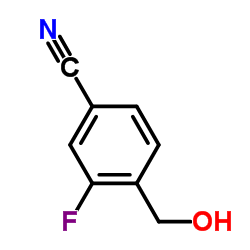
219873-06-0 |
| 文献:MILLENNIUM PHARMACEUTICALS, INC. Patent: WO2006/2099 A2, 2006 ; Location in patent: Page/Page column 103-104 ; WO 2006/002099 A2 |
|
~% 
219873-06-0 |
| 文献:WO2005/123748 A1, ; Page/Page column 93 ; WO 2005/123748 A1 |
|
~96% 
219873-06-0 |
| 文献:BRISTOL-MYERS SQUIBB COMPANY; WATTERSON, Scott, Hunter; DYCKMAN, Alaric, J.; PITTS, William, J.; SPERGEL, Steven, H. Patent: WO2010/85581 A1, 2010 ; Location in patent: Page/Page column 119-120 ; WO 2010/085581 A1 |
|
~27% 
219873-06-0 |
| 文献:BAYER SCHERING PHARMA AKTIENGESELLSCHAFT Patent: US2010/305052 A1, 2010 ; Location in patent: Page/Page column 23 ; |
|
~% 
219873-06-0 |
| 文献:WO2007/69986 A1, ; Page/Page column 74 ; WO 2007/069986 A1 |
|
~99% 
219873-06-0 |
| 文献:Maharvi, Ghulam M.; Fauq, Abdul H. Tetrahedron Letters, 2010 , vol. 51, # 50 p. 6542 - 6544 |
| 上游产品 6 | |
|---|---|
| 下游产品 2 | |
| 海关编码 | 2926909090 |
|---|---|
| 中文概述 | 2926909090 其他腈基化合物. 增值税率:17.0% 退税率:9.0% 监管条件:无 最惠国关税:6.5% 普通关税:30.0% |
| 申报要素 | 品名, 成分含量, 用途 |
| Summary | HS:2926909090 other nitrile-function compounds VAT:17.0% Tax rebate rate:9.0% Supervision conditions:none MFN tariff:6.5% General tariff:30.0% |


